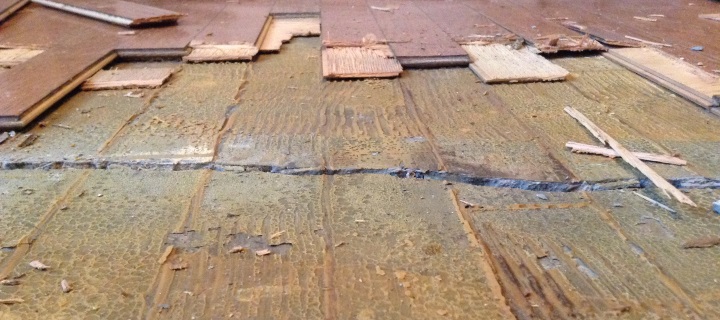Mold & Moisture Behind/On Baseboards & Trim
Mold can grow in many places, including, but not limited to, under baseboard and behind floor trim. All it needs to grow is humidity, moisture, and a certain amount of darkness. For this reason, mold behind baseboards in bathrooms is particularly common.

Dangers of Mold
There are many species of mold and although they vary in how much impact they have on people’s health, most of them can cause health problems and damage to property.
Here are some possible health effects that may be caused by mold:
- Allergies
- Brain fog
- Trouble sleeping
- Fatigue
- Memory problems
If you suspect or see that there is mold growing in your home or business, it is important that you call today for a free estimate on mitigation.
What Does Mold On or Behind Baseboards Look Like?
Mold comes in many colors, but one of the most common and most toxic types of mold that is often found behind baseboards is black mold which is also known as stachybotrys chartarum. That means that if you see black stuff behind your baseboards, there’s a good chance that it could be black mold, but it can also be something less dangerous like mildew. The truth is that It’s hard to tell exactly what it is without doing a proper test. So if you see any sings of something that looks like mold, you should call a professional as soon as possible to take a look at it and come up with a plan of action to get rid of it.
Here are some other common colors of mold that you may find on or behind baseboards:
- Green mold
- White mold
- Yellow mold
- Orange mold
- Purple mold
- Red mold
What Causes Mold Behind Baseboards?
In general, mold cannot grow without a moisture source and it prefers dark environments. For that reason mold behind baseboards is often found in bathrooms or in closets. In order to prevent the mold from growing in your property, you want to get moisture sources fixed quickly. Not to mention that this will save your property from several other issues that water damage causes, like dry rot.
Here are some possible causes of moisture along baseboards:
- Busted or leaky pipes
- Spilled liquids
- Overflowed bathtubs or toilets
- A leaky roof
- Regular moisture from showers and other places in bathrooms
How to Check for Moisture
If you are interested in detecting moisture, you can use a moisture meter to identify where it may be coming from. This may not always be obvious as it could be a structural problem where water has been building up over time. To be sure you get this right, you should hire a restoration professional like ourselves to help you out.
If your home or business has been affected by water damage in the past, you should also consider using use a moisture meter to make sure all of the water has been properly dried, thus affirming that no mold can grow. You can also hire a plumber or leak detection company to check for any leaks.
What to Do If You Have Mold on Under Baseboards and/or Behind Floor Trim
If you visibly see mold in your property, you should assume that it is harmful and contact the number on our website to reach a pro who can help remove it for you. The longer you wait, the more likely you are to see damages to your health and property.
On the other hand, even if there is no visible mold in your property, it is still possible for there to be mold present, and for you to experience health effects from it. That being said, if you suspect that you have mold in your property, but you don’t know for sure, you should get it tested.
How Professionals Treat/Get Rid of Mold Behind Baseboards
There are various steps professionals take to remediate mold. Here are a few of the best practices:
1. Dry Any Moisture Source That May Be Present
As we mentioned earlier, there may be a moisture source that is causing the mold to grow and expand. A professional will seek this out and shut it off as soon as possible.
2. Use a Specialized Mold Spray to Clean the Visible Mold
If the fungus growth is still in the early stages, it is possible to remove it using a specialized mold spray like Mold Armor. Even though it may seem intuitive to use a household cleaner like bleach to clean the mold, that is not a good idea as these cleaners can put the mold into panic mode, causing it to release spores into the environment.
3. Demolishing Any Non-Salvageable Areas
If there is too much mold, the company you hire may need to demolish the affected areas and replace them. This method of removing the mold is effective, but often times it will be more expensive. Therefore, it is best to remediate the mold before it becomes a major problem and requires demolition.
4. Filter the Air
If the mold has been in your property for a while, it is probably contaminating the air. In this case, your professional may use an industrial HEPA filter during the remediation process to filter the air of toxins. If you would like to purchase a HEPA filter to decontaminate the air of toxins after they leave, you can purchase we recommend this one that can be found on Amazon. An added benefit to using an air purifier is that it will also clean the air of other toxins and allergens, in addition to mold.
5. Dry Wet Areas
The contaminated area should be properly dried to prevent the mold from growing back. It is a good idea to use fans, dehumidifiers, and raised temperatures to dry the area. That being said, water damage restoration is somewhat complicated, and your mold remediation professional can advise you on how to do it properly.
6. Check for Mold in Other Areas
If there is mold behind your baseboards, chances are that there will be mold in other areas of your home or business as well because spores will spread through the air. Mold moves and spreads by releasing spores. If these spores come across another habitable environment, one that is dark, damp, and humid, there is a good chance that they will form another colony. This creates a snowball effect because this new colony will eventually start to release spores and could potentially cause another colony to grow in another part of the property. To detect other colonies that may not be visible to the naked eye, we recommend hiring a mold testing and inspection professional or purchasing a mold testing kit.
Monitor the Affected Area over Time
Whether you choose to hire a pro or do it yourself, it is important to constantly monitor mold growth to make sure that it doesn’t come back. If it does grow back, it is a sign that the mold and/or the moisture issue was not mitigated properly and will need to be redone. If you performed the mitigation process yourself the first time, we recommend hiring a professional this time to make sure it is done properly.
Avoid Future Outbreaks
In order to avoid being the victim of mold in the future, it is a good idea to try and avoid water damage as much as possible in your home or commercial building. One of the places that you should particularly be on the look out for water damage and mold growth is under baseboards in bathrooms. This is mainly due to the regular moisture in those areas.
If you notice any mold issues anywhere in your property, give the number on our website a call to reach a local professional anywhere in the USA who can remediate it!
